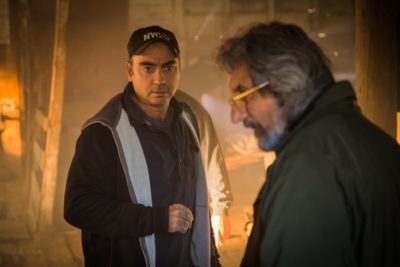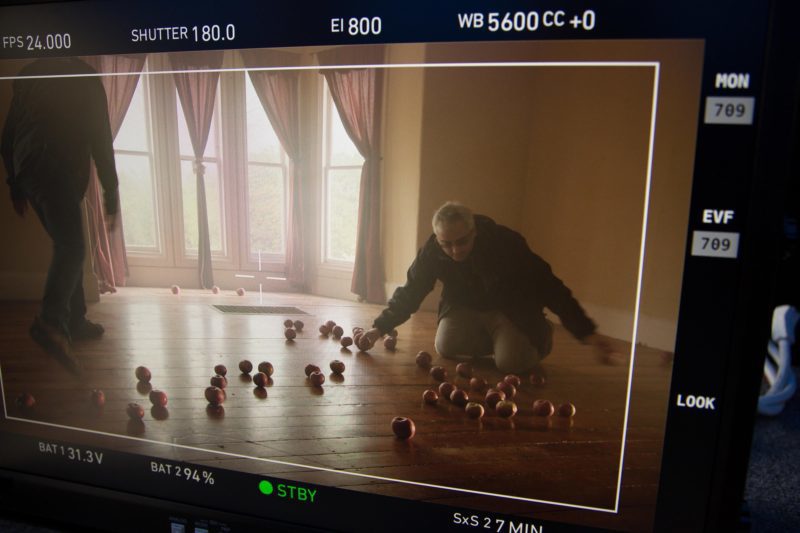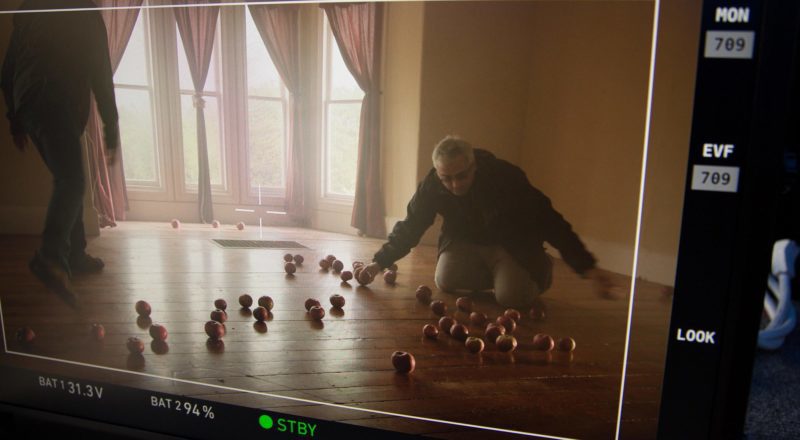INTERVIEW: ‘God Knows Where I Am’ explores mental illness with one woman’s story

God Knows Where I Am, the new documentary from filmmakers Jedd Wider and Todd Wider, follows the tragic and unsettling story of a woman with a mental illness who spends her final days in an abandoned country house with nothing but apples to eat. Linda Bishop’s final days are now known to the outside world because she kept a detailed and often poetic diary of her meals, her thoughts and her beautiful descriptions of life around the house.
Ultimately, Bishop’s story is a cautionary tale and yet another example of how society and the health care system have failed to help a person suffering from mental illness. In Bishop’s case, she endured severe bipolar disorder with psychosis and was estranged from her sister and daughter. No one knew her whereabouts during these final months, and that meant there was no way to help her, to give her food, to keep her warm.
Bishop’s story, which first appeared in a New Yorker article, may have been set in New Hampshire, but it was actually an incident in New York City that inspired the Widers to look at the issues of mental illness and homelessness.
“So Todd and I have been producing documentary films for close to 17 years,” Jedd said in a recent phone interview. “We tend to gravitate towards socio-political films that resonate with us, topics where we feel light is not adequately shined on a particular issue, and very often there’s some sort of grave injustice that we want to attempt to write through the documentary. We came to this topic because Todd had a personal experience in New York City with a homeless person who had broken into the building where Todd lives in the city during the winter. And Todd came home that night. The man was in the foyer. He didn’t know what was going to happen, but it turned out that the man was simply homeless and was freezing cold and was just looking for warmth.”
The police arrived, and they asked Todd what he wanted to do about the man. Todd responded that he simply wanted him to find help, perhaps a warm place to sleep and maybe some food. The man got into the police car, and this is what happened next:
“The police car drove up several blocks,” Jedd said. “The door opened, and the man jumped out into the night in the middle of a snowstorm. And several months later, Todd came out of his building and saw the same man who was sitting in a chair out on the sidewalk, and every time Todd came in and out of the building had seen that the man was out there, day after day after day. He seemed to be completely disoriented. He had urinated all over himself, did not appear to be eating at all and appeared to be severely mentally ill. Todd kept calling the police to come down to get the man help, and eventually after about the 20th call that he had made, the police sent a community rep down.”
The saga continued until Todd realized there wasn’t much of a system in place to help the man. That reality was a difficult lesson to be learned. Todd and Jedd started thinking how they could respond to the incident through their filmmaking.
“It’s not a criminal justice issue,” Jedd said. “It’s an issue for our society, and unfortunately way too many people who are severely mentally ill and harmless fall through the cracks of a broken health care system and safety net that’s meant to be there to take care of these people but very often fails to do so. And so we went out looking for a story, a particular story, that would provide with a window to explore these larger issues, and we came across Rachel [Aviv’s] article in The New Yorker. And we read that, and from there, we went off. And we developed a very close relationship. We reached out to Joan Bishop, Linda’s sister, and Caitlin, Linda’s daughter, and we began to explore Linda’s life and Linda’s story through both of them. And then eventually Joan turned over the journals of Linda to us, and we realized that we had the voice of this woman who died so tragically. And that really was the story we wanted to tell from a personal perspective.”
Jedd said that both Joan and Caitlin wanted to understand the approach that the filmmakers were going to take with the film. Linda’s story is difficult and painful, and the documentary explores her many broken relationships, her starving for food, her fights, her resistance to help. Any family member would give pause if a documentary team came knocking on the door.
“We came to this story because we felt that there was a grave injustice done here to this woman,” Jedd said. “Unfortunately there are thousands of Linda Bishops all across this country. This is not an isolated case. This is a particularly horrific case, but it’s not an isolated case. We made it clear that we wanted to explore our larger American societal issues and how our country addresses these types of issues and fails very often — not always, but often fails — to properly care for and treat the homeless and the severely mentally ill. So we spent a significant amount of time with them explaining our vision, not only from a socio-political perspective but from an artistic perspective as well.”
Having Linda’s journal allowed the filmmakers the chance to present the story in an artistic manner. There’s a voiceover from Lori Singer that dramatizes Linda’s actual words, and the directors used the farmhouse as a backdrop to her poetic recitations.
“We came to understand that Linda was a very intelligent woman,” Jedd said. “She was highly artistic. She was filled with life during her life, and she loved art. She loved cooking. She grew up working on a farm. She saw things very visually. She loved animals. She was a wonderful mother when she had full clarity. … She speaks very poetically as she sits there in a rocking chair in the attic of this abandoned farmhouse looking out a window as life goes on outside the house. She makes these beautifully poetic observations — ‘a cardinal landing on a lilac.’ She talks about astronomy. She talks about food. She talks about nature. She talks about art, and so we wanted, in many ways, to contribute to that artistic sensibility and visual way that Linda looked at life.”
Todd said the team shot the film over two years, including two winters, two falls and a spring. It took approximately two more years to edit the film. The editing was complicated, especially since they switched directions after looking at their footage. They were also helped by editor Keiko Deguchi.
“We were very fortunate to wind up with Keiko Deguchi, who is a superb, seasoned, particularly perceptive editor,” Todd said. “We had always wanted to create the film essentially to motor in two different arcs. One arc would be the main arc, which was Linda’s own words, which starts when she arrives at the house and winds up at the end of the diary, and the other arc, the secondary arc, would be the supporting characters that tell the story of what may or may not have happened beginning with the discovery of the body of Linda.”

Todd said he believes the system failed Linda in many respects. For example, he said this country has an irrational preoccupation with privacy and the protection of privacy, sometimes at the expense of a patient’s well-being. In the film, Linda wins a court hearing that allows her to make her own medical decisions and essentially cut her sister out of her life. This meant that when Linda was discharged from a mental health facility, no one found out about the decision or where she intended to go.
“She didn’t want any phone calls,” Todd said of Linda. “She didn’t want anyone to know if she was there or not, so when her sister or her daughter would contact the hospital, they would be told, we cannot confirm or deny that your mother or your sister is even here. So they were never notified when she was discharged. … Part of that is, of course, fear of litigation and liability and all of that crap.”
Todd added: “Often when you analyze these situations, the common sense aspect to treating patients just gets thrown out the window, and it’s replaced by this fear of liability and litigation. And that’s one of the reasons, in my opinion, that our medical costs are so high because there is this fear of liability, and it makes people do things that they might not ordinarily do certainly based on common sense. So that’s one way the system failed her. The other way, of course, is that when she went in front of the judge who was going to be ruling on whether or not she could remain her guardian or her sister would be awarded guardianship of her while she hospitalized in a mental hospital, the judge decided that Linda could be her own guardian. And as Joan says in the film, if the judge had spent next to two or three minutes speaking with her, her paranoid ideation would have come forward, and you would have seen that she was indeed deeply disturbed. And she really was not in a place where she could be her own guardian. Certainly if she wasn’t medicated, she couldn’t be her guardian. That was a mistake frankly, and that guardianship decision was one in a series of dominoes that fell over in a certain direction heading toward tragedy.”
Now Linda’s story lives on as a cautionary tale about how homelessness and mental illness continue to be problems in society.
By John Soltes / Publisher / John@HollywoodSoapbox.com
God Knows Where I Am is currently playing in theaters. Click here for more information.


Hello: As addendum to the story, please take a look at these helpful resources that are given by the filmmakers. If you are looking for mental health resources in your community: http://godknowswhereiam.com/contact-2/
From their website:
The National Alliance on Mental Illness
https://www.nami.org/Find-Support/NAMI-Programs
If you are in crisis, call:
Lifeline
1-800-273-8255 (24/7)
Or text:
Crisis Text Line
Text START to 741-741
Or visit:
Suicide Prevention Lifeline
http://www.suicidepreventionlifeline.org
Resources on Bipolar Disorder:
International Bipolar Foundation
http://ibpf.org/about-bipolar-disorder
Mayo Clinic
http://www.mayoclinic.org/diseases-conditions/bipolar-disorder/basics/definition/con-20027544
International Society for Bipolar Disorders
http://www.isbd.org/advocacy-and-patient-resources/patient-resources
Bipolar Network News
http://www.bipolarnews.org
The National Alliance on Mental Illness
https://www.nami.org
Depression and Bipolar Support Alliance
http://www.dbsalliance.org/
The Juvenile Bipolar Disorder Foundation
http://www.jbrf.org/
Mental Health Network of America
http://www.mentalhealthamerica.net